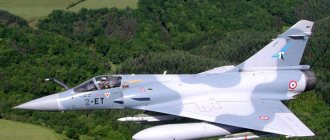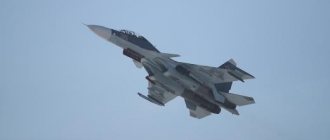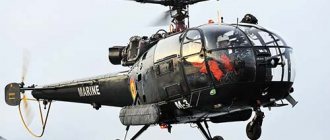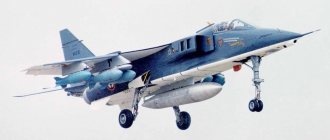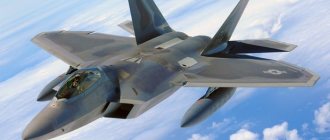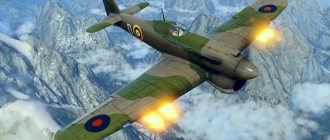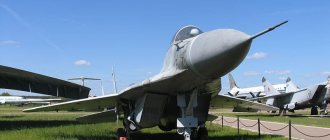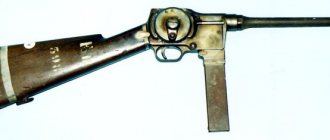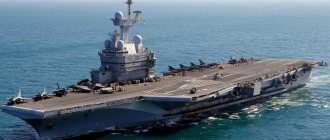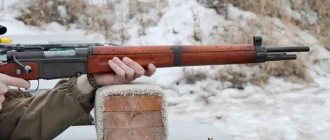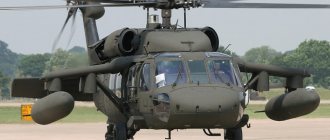Fighters
Dassault Mirage F1. Multirole fighter. (France)
Dassault Mirage F1 is a French light multi-role fighter. Designed to intercept air targets, strike operations and conduct reconnaissance. It is a successor to the Mirage III/5 series aircraft.
In 1964, Dassault-Breguet won a government contract to build a prototype Mirage F.2 two-seat fighter with a conventional wing and tail and a SNECMA/Pratt-Whitney TF306 turboprop engine. This aircraft made its maiden flight in June 1966, followed by the Mirage F.1, a smaller single-seat fighter, in December of the same year. The experimental Mirage F.1 crashed, but it was still considered promising, and in September 1967 the French government ordered 3 pre-production copies. The first of them took off in March 1969.
Dassault Mirage F1. Multirole fighter. (France)
Powered by the SNECMA Atar 9K-31 engine, the first Mirage F.1 had impressive performance. It developed a speed of 2.12 M, or 2260 km/h at an altitude of 11,000 m and 1300 km/h at the ground. Excellent takeoff and landing performance was the result of the use of a system of means of increasing lift, which included a downward deflection of the wing tip and large flaps located on the highly swept wing. With an average combat load, the Mirage F.1 aircraft could take off and land on a strip with a length of 500 to 800 m.
Although Mirage III and Mirage F.1 had almost the same overall dimensions (in particular, the same area washed by the air flow), the amount of fuel reserve of the latter was 40% greater, which was achieved by abandoning bubble-type fuel tanks and using all the free internal space for fuel designs.
This is the only aircraft of the Mirage series made according to a normal aerodynamic design. The rejection of the statically stable “tailless” design, according to which the previous Mirage III/5/50 and Mirage aircraft were designed, is associated with a disadvantage characteristic of this design - low values of the lift coefficient of a balanced aircraft, which significantly worsens maneuverability and takeoff and landing characteristics, so important for a fighter. The wing is all-metal, two-spar. The fuselage is semi-monocoque. The aircraft's structure uses mainly aluminum alloys.
For an interceptor, it is important to quickly respond to the command to “take off.” The Mirage F.1's support equipment is kept to a minimum, and what equipment does exist is entirely transportable by air. It used its own starter, and a central pressure filling system allowed the internal tanks to be filled in approximately 6 minutes. The Mirage F.1 aircraft could be alerted within two minutes thanks to the use of the GAMO self-propelled preparation cart. It used electrical energy to preheat the navigation and weapons systems, fluid-cooled the radar and controlled the cockpit air conditioning, and carried a sunshade on a telescopic pole so that the pilot could sit in the cockpit at full alert for extended periods, even in hot day.
Dassault Mirage F1. Multirole fighter. (France)
Serial production was carried out from 1978 to 1990. During this time, more than 770 aircraft of various modifications were produced, including 251 aircraft for the French Air Force, 18 for Ecuador, 40 for Greece, 113 for Iraq, 36 for Jordan, 33 for Kuwait, 38 for Libya , 50 for Morocco, 15 for Qatar, 48 for South Africa and 73 for Spain.
Options:
- The Mirage F.1A is a strike fighter variant for attacking ground targets during daylight hours. Equipped with less complex avionics and increased fuel capacity. Manufactured under license in South Africa.
- Mirage F.1B - designation of a two-seat trainer aircraft with dual (in the rear cockpit) radar screen and heads-up display (first flight May 26, 1976).
- Mirage F.1C is a fighter-interceptor, the first production copy of which flew on February 15, 1973. Deliveries to the Air Force began on March 14, 1973.
- Mirage F.1C-200 is the designation of 25 French Air Force F.1C aircraft after the installation of in-flight refueling booms.
- The Mirage F.1E is a variant similar to the F.1C aircraft, but with more comprehensive navigation and attack systems, making it suitable for flying in all weather conditions. One F.1E aircraft was produced with a SNECMA M53 turboprop engine, but its creation was subsequently abandoned.
- Mirage F.1D is a two-seat version of the F.1E.
- Mirage F.1R (CR) is a tactical reconnaissance variant with standard cameras, electromagnetic, optical and infrared sensors, with a modern inertial guidance system and radar navigation system. In the French Air Force it is designated F.1CR (first flight November 20, 1981).
In 1992-1996. for the French Air Force, 55 F.1C interceptors were converted into F.1CT strike aircraft (the first flight took place on May 3, 1991, the first F.1CT aircraft were delivered to the operational squadron on November 6, 1992).
Mirage F.1 aircraft are equipped with the Thomson-CSF Cyrano IV or Cyrano IVM monopulse radar, which searches, acquires and tracks air targets at any altitude and has an 80% greater range than the Cyrano II radar used on Mirage III aircraft. Firing can be carried out automatically using a fire-control computer or manually, when the computer gives the pilot permission to hit the target. On F.1CR and F.1CT aircraft there is a Cyrano IVMR radar, which can additionally operate in terrain mapping mode, providing flight over ground obstacles and measuring range to ground objects.
Dassault Mirage F1. Multirole fighter. (France)
The equipment also includes an HUD, a LMT TACAN radio navigation system, an SFENA 505 autopilot, a central air data computer, a Kruse 63 navigation indicator, two VHF transceivers, and a national identification system. Suspension of containers with a laser target designator, reconnaissance and electronic warfare equipment is provided.
The F.1CR reconnaissance aircraft is in fact the first French Air Force aircraft whose on-board equipment is almost entirely digital. It is equipped with the SNAR navigation and reconnaissance complex with on-board computer 182 and INS SAG EM "Ulysses" 47. The onboard radar "Cyrano" IVMR in combination with the INS allows you to perform tasks in difficult weather conditions. The reconnaissance equipment includes two cameras and an SCM 2400 “Super Cyclops” IR radiation receiver-analyzer. IR images are recorded on videotape or can be transmitted directly to a ground station via a microwave link with pre-processing on board the aircraft. It is possible to place additional equipment in hanging containers. The F.1CT is equipped with radar warning receivers, an improved INS and a navigation computer.
Mirage F.1 aircraft are armed with two DEFA 553 cannons (30 mm caliber, 125 rounds each), F.1CR and F.1CT aircraft are armed with one. The maximum design load on the external suspension units is 6300 kg. Operational combat load 4000 kg. When performing an interception mission, the aircraft can carry two Matra Super 530 medium-range air-to-air missiles under the wing or two Matra 550 Magik, or AIM-9 Sidewinder close-in air-to-air missiles at the wing tips. When carrying out strike operations, the combat load can include one AS.30 air-to-surface missile, fourteen 250 kg bombs, eight 450 kg bombs, four NAR units, containers with weapons and napalm tanks.
Mirage F.1 aircraft have taken part in several military conflicts, the largest of which (the Iran-Iraq War of 1980-1988 and the Gulf War in 1991) are associated with the actions of the Iraqi Air Force, which has the first largest fleet of Mirage F aircraft. 1 among importing countries.
Dassault Mirage F1. Multirole fighter. (France)
Characteristics:
- Crew: 1 pilot;
- Length: 15.23 m;
- Wingspan: 8.4 m;
- with wingtip rockets: 9.32 m;
- Height: 4.5 m;
- Wing area: 25.0 m²;
- Leading edge sweep: 47° 30′;
- Chassis base: 5.0 m;
- Chassis track: 2.5 m;
- Empty weight: 7400 kg;
- Normal take-off weight: 10,900 kg (without suspension);
- Maximum take-off weight: 16,200 kg;
- Fuel mass in internal tanks: 3350 kg (+ 3580 kg in PTB);
- Fuel tank volume: 4300 l;
- Powerplant: 1 × SNECMA Atar 9K-50 turbofan engine;
- Non-afterburning thrust: 1 × 49.03 kN (5000 kgf);
- Afterburner thrust: 1 × 70.61 kN (7200 kgf);
- Maximum speed: near the ground: 1470 km/h (M=1.2); at altitude: 2335 km/h (M=2.2);
- Cruising speed: 885 km/h;
- Landing speed: 230 km/h;
- Combat radius: with 14 × 250 kg bombs in a “large-small-large” profile altitude: 425 km; with 1 × AM.39 and 2 × 1200 l PTB along the “small-small” profile altitude: 700 km;
- Ferry range: 3300 km;
- Flight duration: 3 hours 45 minutes;
- Patrol duration: 2 hours 15 minutes (with 2 × Matra R530 and 1 × 1200 l PTB);
- Service ceiling: 20,000 m;
- Small arms and cannon armament: 2 × 30 mm DEFA 553 cannons with 125 rounds of ammunition per gun;
- Hardpoints: 7 (1 under the fuselage with a load of 2100 kg, 2 internal under the wing with a load of 1300 kg, 2 external under the wing with a load of 550 kg, 2 at the ends of the wing for V-V missiles) with a load of 150 kg );
- Combat load: 4000 kg;
- Guided missiles: air-to-ground missiles: 1 × AS.37 Martel or AS.30 (or AM.39 or AS.30L for export aircraft); air-to-air missiles: 2 × Super R 530 and 2 × R550 Magic or AIM-9;
- Unguided rockets: 4 Matra blocks with 18 × 68 mm rockets;
- Bombs: free-falling (8 × 454 kg high-explosive bombs, 14 × 250 kg high-explosive bombs, 6 × 600 liter napalm tanks);
- Outboard fuel tanks: 3 × 1200 l.
Dassault Mirage F1
France
In 1984, the first operational deployment of the French Air Force Mirage F1 was during Operation Manta, the French intervention in Chad to counter the growing Libyan incursion into the region. A formation of four Mirage F1C-200s provided air cover for another formation of four Jaguar strike aircraft; they were also involved in a number of skirmishes with pro-Bivian rebels of the Transitional Government of National Unity (GUNT).
A pair of French Air Force Mirage F1Cs from EC 2/30 and EC 3/30 in flight, 31 May 1986.
In 1986, French Mirage F1s were deployed to Chad as part of Operation Epervier. A flight of four F1C-200s provided fighter cover for a strike force of eight Jaguars during an air raid on the Libyan air base at Wadi Doum on 16 February. [13] A pair of F1CRs also conducted pre- and post-strike reconnaissance missions. [14]
In response to the Iraqi invasion of Kuwait, France carried out two Mirage F1 deployments to the Persian Gulf. In October 1990, 12 Mirage F1Cs were sent to Doha, Qatar, to strengthen air defense, and four more Mirage F1CR ER 33s were sent to Saudi Arabia as part of Operation Daget in September 1990. [15] [16] [17] To avoid the risk of being mistaken for hostile Iraqi Mirage F1s, all French F1CRs were grounded during the first few days of Allied air attacks, flying their first combat mission on 26 January 1991; an additional reason for their initial grounding was the lack of compatible night vision equipment. [18] [19] They were used in the fighter-bomber role, using their more advanced navigation systems to guide formations of French Jaguar fighter-bombers, as well as carry out reconnaissance missions; in this capacity, by the end of hostilities, 114 sorties were flown. [15] [1] Following the end of the Gulf War, France stationed several Mirage F1CR aircraft at bases in neighboring Turkey as part of Operation Provide Comfort to protect the Kurds from Iraqi aggression. [15]
In November 2004, in response to an air attack by Ivorian forces on French peacekeepers, a formation of three Mirage F.1 aircraft struck Yamoussoukro Airport, destroying a total of two Su-25 aircraft and three attack helicopters. [20]
A multinational fighter force including, from left to right, a Qatari F-1 Mirage, a French F-1C Mirage, a USAF F-16C Fighting Falcon, a Canadian CF/A-18A Hornet, and a Qatari Alpha Jet, during Operation Desert Shield
In October 2007, three Mirage 2000s and three Mirage F1s were deployed to Kandahar Air Force Base, where they flew close air support and tactical reconnaissance missions in support of international forces in Southern Afghanistan. [21] [22]
The last French unit equipped with the Mirage F1 was Escadron de Reconnaissance 2/33 Savoie
, based at Mont-de-Marsan, which flew the latest version of the F1CR. The unit's primary mission was tactical reconnaissance, with a secondary mission being ground attack; Because of 2/33's unique missions, their unofficial motto among pilots became "Find, Identify, Photograph or Destroy." In accordance with the bilateral defense agreement between France and Chad, the pair of 2/33 F1CRs along with 3 pilots, a photographic translator, an intelligence officer and ground crews were always assigned to N'Djamena, Chad. Two 2/33 F1CRs operated with three Mirage 2000Ds, also on a rotation basis from France to Chad. [23]
In March 2011, 2/33 Mirage F1CRs were deployed to Solenzara Air Base, Corsica and conducted reconnaissance over Libya (also a Mirage F1 operator) as part of OPERATION Harmattan. [24] In 2013, 2/33 F1CR also participated in Operation Serval in Mali. On 10 January, F1CRs and Mirage 2000Ds, supported by a French Air Force C-135K tanker, carried out the first launch of the French air intervention against Islamist rebels in Mali from their base at N'Djamena in Chad. 2/33 F1CRs provided valuable photographic information for attack aircraft flying out of France the next day. Later, on 16 January, two 2/33 F1CRs were transferred from Chad to Bamako, Mali. Both aircraft were equipped with 2,200 liter extended range ventral tanks; and when flying over Mali they also carried two 250 kg unguided bombs plus one internal 30 mm cannon in case they were deployed for close air support. [25]
To replace the old F1CR 2/33, several Rafales were equipped with an advanced reconnaissance pod. The Rafale's range, maneuverability and payload are far superior to the F1CR it replaces, as well as its reconnaissance capabilities: once the Rafale capsule has taken photographs, they can be transmitted almost instantly back to its base or wherever the images may be needed. provided compatible downlink equipment is available. [23] The last Mirage F1 fighters of the French Air Force were withdrawn from service on 13 June 2014. The last units in service, including 11 single-seat Mirage F1CRs and three two-seat F1Bs, were transferred to storage; six aircraft made their final takeoff during Bastille Day celebrations over Paris before being scrapped. [26]
Ecuador
Between 1979 and 1980, Ecuador received 16 F.1JAs (F1E variant) and a pair of F.1JEs. Squadron of Mirage F1JAs ( Escuadrón de Caza 2112
) The Ecuadorian Air Force (FAE) entered service in January–February 1981 during the short Paquisha War between Ecuador and Peru, less than two years after the aircraft was delivered to FAE. At that time, the Ecuadorians decided not to directly challenge the Peruvian Air Force (abbreviated FAP), whose Mirage 5P and Su-22 aircraft provided air cover for Peruvian helicopter operations in the combat zone. Instead, the Mirages kept their distance, conducting combat air patrols (CAPs) on the outskirts of the combat zone in case border skirmishes escalated into wider hostilities. During one incident, a Peruvian Su-22 was intercepted and a single R.550 air-to-air missile was fired; however, it was unable to hit the Peruvian aircraft. [27]
An Ecuadorian Mirage F.1JA during the joint US-Ecuadorian exercise Blue Horizon '86.
In 1995, during the Cenepa War, Ecuadorian mirages began to operate against Peru again. This time, while the bulk of the squadron was at Taura Air Base, a small force of Mirage F1s and Kfir C.2s were deployed to undisclosed forward air bases to dissuade Peruvian ground attack aircraft from entering the combat zone. By this time, the aircraft had been upgraded with Israeli electronics and Python Mk.III air-to-air missiles, typically mounted on outer underwing pylons, and Matra R550 Magic surface-to-air missile systems on wingtip launch rails. [ citation needed
]
On 10 February 1995, a pair of Mirage F1JAs, piloted by Major Raul Banderas and Captain Carlos Uzcategui, hit five targets approaching the Cenepa Valley combat zone. Following visual contact, the Mirages fired their missiles, claiming that two Peruvian Su-22Ms had been shot down, while the Kfir captured another A-37B Dragonfly. [28] [29] [30] [31] Sources in Peru, however, deny claims that the Su-22Ms were shot down by Ecuadorian aircraft, claiming that one of them was shot down by Ecuadorian anti-aircraft artillery fire while low-flying the attack aircraft , and the second was lost due to an engine fire. [32] [33] [34] Banderas served as commander of the Ecuadorian Air Force from May 2014 to February 2016, and Uzcategui died in a training accident in 2002 at Salinas Air Base in Santa Elena province. [35] [36] [37] [38]
In 2011, all remaining Ecuadorian Mirage F.1s were retired after having flown more than 33,000 flight hours during 32 years of active service; They were replaced by a squadron of Atlas Cheetah fighters purchased from South Africa. [39]
Iraq
In the late 1970s, Iraq placed an order for a variant of the Mirage F1, designated Mirage F1EQ, which was specifically modified to increase range for strike missions and was unlike any model operated by the French Air Force. [40] During this period, France was the country's main supplier of military equipment; in 1983, the former lent Iraq several Dassault-Breguet Super Étendards while the latter awaited delivery of the Mirage F1EQ, which experienced a long development period and consequent delivery delays. [41] Super Étendard strongly supported Dassault, fearing the possible cancellation of a significant order for the Mirage F1 by Iraq if the request was not granted. [42]
In 1982, it was decided to reconfigure several idle Iraqi Mirages F1s from a general combat configuration into a dedicated ground attack platform, adopting sophisticated Thomson-CSF electronic warfare equipment and significantly increasing payload capacity, including the newly developed AC-air-to-surface missile. thirty . [43] In this role, the Mirage F1 was used to replace the aging Iraqi fleet of Hawker Hunters. [44] In September 1985, an agreement was signed between Dassault and Iraq for the supply of an additional 24 aircraft. [45]
During the Iran–Iraq War, Iraqi Mirage F1EQ helicopters were used extensively for interception, ground attack, and anti-shipping operations. [46] The Mirage F1EQ allowed Iraq to strike Iran within a larger combat radius than previously possible. [47] In November 1981, an Iraqi Mirage F1 shot down the first Iranian F-14 Tomcat, followed by several more in the following months, giving the previously timid Iraqi Air Force new confidence in air-to-air combat. clashes with the Iranians. [48] According to research by journalist Tom Cooper, during the war, 33 Iraqi Mirage F1s were shot down by Iranian F-14s, [49] and two were shot down by Iranian F-4 Phantom IIs. [50] Iraqi F1EQ claimed at least 35 Iranian aircraft, mostly F-4s and Northrop F-5E Tiger IIs, as well as several F-14 Tomcats. [51] [ page needed
]
On September 14, 1983, a pair of Turkish Air Force F-100F Super Sabers from 182 Filo Atmaka invaded Iraqi airspace. An Iraqi Air Force Mirage F-1EQ intercepted the flight and fired a Super 530 F-1 missile at them. One of the Turkish fighters (serial number 56-3903) was shot down and crashed in the Zakho Valley near the Turkish-Iraqi border. It is reported that the pilots of the plane survived the crash and were returned to Turkey. The incident was not made public by either side, although some details emerged in later years. The incident was disclosed in 2012 by Turkish Defense Minister İsmet Yılmaz in response to a parliamentary question from Republican People's Party (CHP) MP Metin Lutfi Baydar following the downing of a Turkish F-4 Phantom II in Syria in 2012. [52]
On May 17, 1987, an Iraqi Mirage F1 fired a pair of Exocet missiles at the United States Navy (USN) ship USS Stark while on patrol in the Persian Gulf, causing extensive damage to the ship, killing 37 and wounding 21 of Stark's crew. The pilot's exact motives and orders remain unclear, although Iraq later apologized for the attack, calling the incident a "mistake" and blaming Iran. [53]
Before the outbreak of the 1991 Gulf War, the Iraqi Mirage F1EQ fleet was the second largest fleet in the Iraqi Air Force (the most numerous was the MiG-21). [54] On January 17, 1991, in the opening minutes of the conflict, an unarmed United States Air Force (USAF) EF-111 crewed by Captain James A. Denton and Captain Brent D. Brandon killed an Iraqi Mirage. The F1EQ they managed to maneuver into the ground, making it the only F-111 to score an aerial victory over another aircraft. [55] Later in the war, an Iraqi Mirage piloted by Captain Nafi Al-Juburi successfully shot down an American EF-111 Raven in an aerial maneuver when it crashed while attempting to evade a missile fired by Al-Juburi. [56] [57]
Coalition forces shot down several Iraqi F1s during the Gulf War, such as the six F1EQs shot down by USAF F-15 Eagles. A pair of F1EQs that were preparing to carry out a Beluga bomb attack on Saudi oil facilities were shot down by a Royal Saudi Air Force (RSAF) F-15C. [58] [59] Of the 88 Mirage F1EQ aircraft before the conflict, 23 were destroyed during the war, a further six were damaged, and 24 were taken to Iran and interned; By the end of the Gulf War, only 23 aircraft remained in service. [1] Of the 23 Iraqi Mirage F1EQ helicopters destroyed, 9 were destroyed during air combat. [44]
Morocco
Moroccan Mirage F1CH (2007).
In 1975, the Royal Moroccan Air Force (RMAF) placed a large order for 30 Mirage F1CH and 20 Mirage F1EH, the first of which was due to be delivered in 1978. on assault operations and air defense; Making up more than a third of its fighter force, the Mirage F1 served as the RMAF's primary air defense fighter for the next two decades. [60] As early as 1979, these aircraft took part in combat missions against Polisario Front forces operating in Western Sahara. The RMAF lost seven Mirages to enemy fire, as well as another six that crashed due to various incidents. Three Mirage pilots were killed and three were captured. [61] According to political writer Anthony Cordesman, the RMAF struggled to effectively maintain and operate all of its Mirage F1s, possibly due to a lack of funding for spare parts. [62]
South Africa
A formation of four Mirage F1CZs flying over Ysterplaat Air Base, circa 1982.
In 1971, South Africa began searching for a replacement for the Mirage III; As a result, it was decided to purchase a license to manufacture the Mirage F1 and its engine, with the intention of producing up to 100 Mirage F1s. However, this license was quickly revoked due to the looming arms embargo of 1977. The SAAF proceeded to purchase 16 Mirage F1CZs and 32 Mirage F1AZs, which were quickly delivered from Dassault before the embargo came into effect, the first of these births occurring in 1975.
Both the F1CZ and F1AZ variants of the South African Air Force (SAAF) saw action during the Border War. In November 1978, the first five F1CZs were deployed to South West Africa (Namibia) and were tasked with providing escort for reconnaissance flights over Southern Angola. Since 1980, the use of escort aircraft has become regular. Due to problems with the F1AZ, the F1CZ were initially assigned to a strike role in southern Angola using Matra M155 rocket pods or 250 kg bombs. [ citation needed
]
F1CZs of 3 Squadron shot down two Angolan MiG-21s in 1981 and 1982. On 6 November 1981, during Operation Daisy, two F1CZs were sent by GCI to intercept two MiG-21s heading south. Major Johan Rankin shot down the wingman with artillery fire as the missiles failed to engage the MiGs. On 5 October 1982, while accompanying No. 12 Squadron Canberra on a photo reconnaissance mission, Rankin and his wingman engaged two MiG-21s on an intercept course. He fired two Magic ADSLs - on one of the MiGs, damaging the plane with the second missile. Rankin then attacked the second MiG and destroyed it with cannon fire. [63] The first MiG was able to return to base, but suffered further damage when it landed on its belly.
In May 1982, an Angolan Mi-8 helicopter, believed to be carrying senior officers by the SADF, was discovered and destroyed in the Cuvelai area. The helicopter with rotors was discovered by a pair of F1CZs and destroyed by 30mm gun fire. [ citation needed
]
Two F1AZs from 1 Squadron were lost over Angola. On 20 February 1988, during a flight interdiction sortie in F1AZ "245" against a road convoy during Operation Hooper, Major Ed Each was shot down by an SA-13 Gopher SAM. F1AZ '223' was lost almost a month later, on 19 March, when Captain Willy van Coppenhagen crashed into the ground while returning from a night diversion; The SAAF Board of Inquiry was unable to determine the cause of the crash. [63] [64]
SAAF Mirage F1CZ during aerial display at Ysterplaat Air Force Base, Cape Town, circa 1982
Two F1AZ and F1CZ were also damaged by the enemy, but were able to return to base. On 7 June 1980, during an attack on SWAPO's Tobias Haneko training camp during Operation Skeptic (smoke sink), Major France Pretorius and Captain IC du Plessis were hit by an SA-3 Goa SAM. Du Plessis's plane hit a fuel line and had to make a hard landing at Ondangwa Air Base. Pretorius's aircraft suffered more serious damage and was forced to divert to the forward Ruacana airstrip, where it landed with only the main landing gear extended. Both aircraft were repaired and returned to service. [63] During the final phase of the Bush War, F1AZs flew 683 combat missions and were fired at by over 100 anti-aircraft missiles. [ citation needed
]
On September 27, 1987, Operation Moduler attempted to intercept two Cuban MiG-23ML FAR fighters. Captain Arthur Piercy's F1CZ was damaged by either an AA-7 Apex or an AA-8 Aphid AAM fired head-on by Major Alberto Ley Rivas. The explosion destroyed the aircraft's brake parachute and damaged the hydraulics. Pearcy managed to reach Rundu Air Base, but the plane overshot the runway. The impact with the rough terrain caused Piercy's ejection seat to burst into flames; he was unable to move away from the seat and suffered serious spinal injuries. [63]
In February 1987, three F1AZs unsuccessfully fired several V-3B missiles at a group of MiG-23s. This happened again in February 1988 when an F1AZ fired a missile at a MiG-23 and fired a 30mm cannon, again without success. Various other unsuccessful attempts were made between 1987 and 1988.
In addition to operations in Namibia in July 1981, a Mozambican Air Force pilot defected in his MiG-17. He took off from his base near Maputo towards South Africa. Two F1AZs returning from training intercepted the MiG-17. In March 1981, two F1AZs intercepted a Zimbabwean Army CASA C-212 and forced it to land in South Africa, claiming that the aircraft had invaded South African airspace. [ citation needed
]
The SAAF lost a further six F1AZs and three F1CZs due to various mishaps. F1CZ '205' caught fire after landing and was repaired using the tail section of F1CZ '206' (Pearcey's aircraft). [63]
Spain
Spanish Air Force F.1M at Kecskeméti Repülőnap 2010
.
In June 1975, as tensions with Morocco grew, Spain decided to strengthen its air force and purchased 15 Mirage F1C aircraft, which were transferred to Albacete AB. In mid-1976 there was still some tension with MiG-25 flights to Morocco, Algeria and Libya in the Mediterranean, which led to the Spanish Air Force purchasing ten more Mirage F1Cs and two years later ordering 48 Mirage F1Cs and F1Es. [ citation needed
]
A few years later, Spain also bought 12 retired F1EDA/DDAs from the Qatar Air Force, which donated some of the equipment and weapons used by these Mirage F1s. In Spain, the F1CE was called the C.14A, the F1EE was called the C.14B, and the two-seat F1EDA was called the C.14C.
They served primarily as primary Spanish air defense interceptors and in secondary interception roles until they were supplanted by Spanish EF-18A Hornets. They served with Ala 11 (11th Wing) at Manises (formerly Qatari aircraft), Ala 14 at Albacete and Ala 46 at Gando in the Canary Islands. [65] Ala 46 operated its Mirage F1s primarily as air defense aircraft, using the same dark blue color pattern as the French aircraft.
In October 1996, Thomson-CSF was awarded a 700 million francs ($96 million) contract to upgrade 48 F1C/E single-seat trainers and 4 F1EDA trainers to Mirage F1M standard (see below). The ex-Qatari Mirage F1s were left without an update as they were a different version and were the first to be discontinued. [66] In addition to extending service life, it improved avionics and added anti-shipping capabilities with an upgraded Cyrano IVM radar and Exocet compatibility.
From July 2006 to November 2006, Spanish Mirage F1s were deployed to Lithuania as part of the NATO Baltic Air Policing mission; during this deployment they took off twice to intercept undisclosed intruders. On 20 January 2009, a pair of Spanish F1s from 14 Wing crashed near their base during a routine Spanish Air Force air combat training mission, killing all three crew members. The wreckage of the two planes, including the remains of the crew, was found about 3 km apart. [67] By 2009, 141 Squadron (141 Squadron) "Patanes" and 142 Squadron (142 Squadron) "Tigres" with Ala 14 were operating 38 F1Ms. [65]
In 2013, the Spanish Air Force retired its fleet of Mirage F1s, [68] gradually phasing them out of service as increasing numbers of Eurofighter Typhoons became available. [65] During 2013, it was reported that Spain might sell sixteen F1Ms to Argentina, but they now appear to have the budget to purchase new Kfirs. [69] A deal was struck and Argentina bought the Spanish Mirages in October 2013, [70] but the deal was canceled in March 2014 due to pressure from the UK on Spain not to promote FAA modernization due to tensions between countries from -for the Falkland Islands. Islands. [71] In November 2022, Draken International announced that it had acquired 22 F1M aircraft from Spain and would refurbish and upgrade them for use as enemy aircraft. [72]
Libya
Libya has purchased 36 Mirage F.1AD aircraft to equip the Libyan Air Force as an air superiority fighter. [73] The basic F.1AD model is a dedicated attack variant that lacks a standard radar; instead, it is equipped with a retractable fuel probe mounted in the nose. Subsequently, four F.1ADs were upgraded to a multi-role configuration. [73]
Mirage F1BD, believed to be the only two-seat aircraft of its type remaining in service in Libya at the time, 2009
Libyan Mirage F.1s saw active service in the Chadian war and proved their worth during the Libyan campaigns in 1981 and 1983; however, they were not used later as the Air Force held them back for a possible anticipated confrontation with the US and its allies. In August 1981, a large group of 70 Libyan aircraft, including Mikoyan-Gurevich MiG-23, MiG-25, Su-20, Su-22M and Mirage F1, approached the US Navy carrier battle group in a show of force. They were escorted out of its vicinity by 14 McDonnell Douglas F-4 Phantom IIs and Grumman F-14 Tomcats. [74]
When operating in Chad, the typical combat configuration of the Mirage F1.AD consisted of a pair of 1,300 L drop tanks and a pair of Belouga CBUs. Operations were carried out almost exclusively during daylight hours and from high altitudes, resulting in limited effectiveness. [75] Since 1981, the unit has been stationed in Martin es Serra in southern Libya; since 1983 these Mirage F1s have also been regularly deployed to Faya Larjo in central northern Chad. Along with the Mirage 5, the Mirage F.1 played a major role in the enormous success achieved in the various campaigns against Chadian forces in the early 1980s: operating in open and barren desert terrain, they inflicted heavy damage, making any major troop movements very expensive. no loss during exchange.
A fleet of Mirage F1s saw action during the 2011 Libyan Civil War. The Libyan Air Force posed little threat to coalition forces, partly due to insufficient equipment and heavy reliance on older aircraft acquired from the Soviet Union, but remained effective against poorly armed anti-Gaddafi rebels. [75] On 21 February 2011, a pair of Libyan aircraft landed in Malta after being ordered to bomb protesters in Benghazi; both pilots asked for political asylum. [73] Following the death of Muammar Gaddafi and the end of the civil war, France and Libya entered into an agreement in 2012 to modernize the remaining Mirage F1 fleet, as well as cover the potential purchase of additional Mirage F1s previously used by the French Air Force. [76]
Multirole fighter Mirage F.1 (France)
Multirole fighter Mirage F.1
designed for intercepting air targets, strike operations and reconnaissance.
The Mirage F.1 aircraft is a successor to the Mirage III/5 series aircraft. In 1964, Dassault-Breguet won a government contract to build a prototype Mirage F.2 two-seat fighter with a conventional wing and tail and a SNECMA/Pratt-Whitney TF306 turboprop engine. This aircraft made its maiden flight in June 1966, followed by the Mirage F.1, a smaller single-seat fighter, in December of the same year. The experimental Mirage F.1 crashed, but it was still considered promising, and in September 1967 the French government ordered 3 pre-production copies. The first one flew in March 1969. Powered by the SNECMA Atar 9K-31 engine, the first Mirage F.1
had impressive performance. It developed a speed of 2.12 M, or 2260 km/h at an altitude of 11,000 m and 1300 km/h at the ground. Excellent takeoff and landing performance was the result of the use of a system of means of increasing lift, which included a downward deflection of the wing tip and large flaps located on the highly swept wing. With an average combat load, the Mirage F.1 aircraft could take off and land on a strip with a length of 500 to 800 m.
Although Mirage III and Mirage F.1 had almost the same overall dimensions (in particular, the same area washed by the air flow), the amount of fuel reserve of the latter was 40% greater, which was achieved by abandoning bubble-type fuel tanks and using all the free internal space for fuel designs.
This is the only aircraft of the Mirage series made according to a normal aerodynamic design. The rejection of the statically stable “tailless” design, according to which the previous Mirage III/5/50 and Mirage aircraft were designed, is associated with a disadvantage characteristic of this design - low values of the lift coefficient of a balanced aircraft, which significantly worsens maneuverability and takeoff and landing characteristics, so important for a fighter. The wing is all-metal, two-spar. The fuselage is semi-monocoque. The aircraft's structure uses mainly aluminum alloys.
For an interceptor, it is important to quickly respond to the command to “take off.” Auxiliary equipment for Mirage F.1
reduced to a minimum, and what exists is transported entirely by air. It used its own starter, and a central pressure filling system allowed the internal tanks to be filled in approximately 6 minutes. The Mirage F.1 aircraft could be alerted within two minutes thanks to the use of the GAMO self-propelled preparation cart. It used electrical energy to preheat the navigation and weapons systems, fluid-cooled the radar and controlled the cockpit air conditioning, and carried a sunshade on a telescopic pole so that the pilot could sit in the cockpit at full alert for extended periods, even in hot day.
Serial production was carried out from 1978 to 1990. During this time, more than 770 aircraft of various modifications were produced, including 251 aircraft for the French Air Force, 18 for Ecuador, 40 for Greece, 113 for Iraq, 36 for Jordan, 33 for Kuwait, 38 for Libya , 50 for Morocco, 15 for Qatar, 48 for South Africa and 73 for Spain.
The Mirage F.1A is a strike fighter variant for attacking ground targets during daylight hours. Equipped with less complex avionics and increased fuel capacity. Manufactured under license in South Africa.
Mirage F.1B - designation of a two-seat trainer aircraft with dual (in the rear cockpit) radar screen and heads-up display (first flight May 26, 1976).
Mirage F.1C is a fighter-interceptor, the first production copy of which flew on February 15, 1973. Deliveries to the Air Force began on March 14, 1973.
Mirage F.1C-200 is the designation of 25 French Air Force F.1C aircraft after the installation of in-flight refueling booms.
The Mirage F.1E is a variant similar to the F.1C aircraft, but with more comprehensive navigation and attack systems, making it suitable for flying in all weather conditions. One F.1E aircraft was produced with a SNECMA M53 turboprop engine, but its creation was subsequently abandoned.
Mirage F.1D is a two-seat version of the F.1E.
Mirage F.1R (CR) is a tactical reconnaissance variant with standard cameras, electromagnetic, optical and infrared sensors, with a modern inertial guidance system and radar navigation system. In the French Air Force it is designated F.1CR (first flight November 20, 1981).
In 1992-1996. for the French Air Force, 55 F.1C interceptors were converted into F.1CT strike aircraft (the first flight took place on May 3, 1991, the first F.1CT aircraft were delivered to the operational squadron on November 6, 1992).
On Mirage F.1
a Thomson-CSF monopulse radar "Cyrano" IV or "Cyrano" IVM was installed, which searches, acquires and tracks air targets at any altitude and has an 80% greater range than the "Cyrano" II radar used on Mirage III aircraft . Firing can be carried out automatically using a fire-control computer or manually, when the computer gives the pilot permission to hit the target. On F.1CR and F.1CT aircraft there is a Cyrano IVMR radar, which can additionally operate in terrain mapping mode, providing flight over ground obstacles and measuring range to ground objects.
The equipment also includes an HUD, a LMT TACAN radio navigation system, an SFENA 505 autopilot, a central air data computer, a Kruse 63 navigation indicator, two VHF transceivers, and a national identification system. Suspension of containers with a laser target designator, reconnaissance and electronic warfare equipment is provided.
The F.1CR reconnaissance aircraft is in fact the first French Air Force aircraft whose on-board equipment is almost entirely digital. It is equipped with the SNAR navigation and reconnaissance complex with on-board computer 182 and INS SAG EM "Ulysses" 47. The onboard radar "Cyrano" IVMR in combination with the INS allows you to perform tasks in difficult weather conditions. The reconnaissance equipment includes two cameras and an SCM 2400 “Super Cyclops” IR radiation receiver-analyzer. IR images are recorded on videotape or can be transmitted directly to a ground station via a microwave link with pre-processing on board the aircraft. It is possible to place additional equipment in hanging containers. The F.1CT is equipped with radar warning receivers, an improved INS and a navigation computer.
Mirage F.1 aircraft
armed with two DEFA 553 cannons (30 mm caliber, 125 rounds each), the F.1CR and F.1CT aircraft are armed with one. The maximum design load on the external suspension units is 6300 kg. Operational combat load 4000 kg. When performing an interception mission, the aircraft can carry two Matra Super 530 medium-range air-to-air missiles under the wing or two Matra 550 Magik, or AIM-9 Sidewinder close-in air-to-air missiles at the wing tips. When carrying out strike operations, the combat load can include one AS.30 air-to-surface missile, fourteen 250 kg bombs, eight 450 kg bombs, four NAR units, containers with weapons and napalm tanks.
Mirage F.1 aircraft have taken part in several military conflicts, the largest of which (the Iran-Iraq War of 1980-1988 and the Gulf War in 1991) are associated with the actions of the Iraqi Air Force, which has the first largest fleet of Mirage F 1
among importing countries.
TACTICAL AND TECHNICAL CHARACTERISTICS Crew, persons. 1 Speed, km/h: maximum at an altitude of about 10 km 2350 maximum at an altitude of up to 3 km 1470 cruising 885 Service ceiling, m 20000 Range, km: ferry 3300 action 900 Weight, kg: maximum take-off 15200 empty aircraft 7400 Maximum combat load, kg 4000 Aircraft dimensions, m: wingspan 8.4 length 15.0 height 4.5 Engine: SNECMA-Atar-9K-50 turbofan engine, kgf 5000/7200
